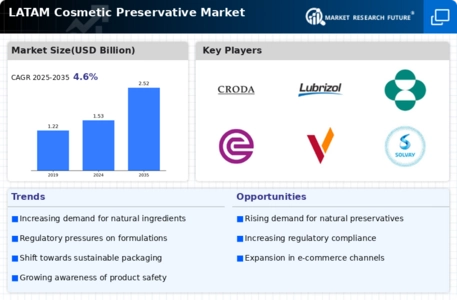Rising Demand for Anti-Aging Products
The LATAM Cosmetic Preservative Market is experiencing a notable increase in demand for anti-aging products. This trend is driven by a growing awareness among consumers regarding skin health and the visible effects of aging. As a result, cosmetic manufacturers are formulating products that require effective preservatives to maintain product integrity and safety. The anti-aging segment is projected to grow at a compound annual growth rate of approximately 7% over the next five years, indicating a robust market potential. Preservatives play a crucial role in extending the shelf life of these products, thereby enhancing their appeal to consumers. Consequently, the demand for innovative and effective preservatives is likely to rise, shaping the future landscape of the LATAM Cosmetic Preservative Market.
Expansion of the Middle-Class Population
The expansion of the middle-class population in LATAM countries is significantly impacting the LATAM Cosmetic Preservative Market. As disposable incomes rise, consumers are increasingly willing to invest in personal care and cosmetic products. This demographic shift is leading to a surge in demand for a variety of cosmetic products, which in turn drives the need for effective preservatives. The middle-class segment is projected to grow by approximately 5% annually, contributing to a larger consumer base for cosmetic products. Consequently, manufacturers are likely to focus on developing preservatives that cater to this expanding market, ensuring product safety and longevity. This demographic trend is expected to play a pivotal role in shaping the future of the LATAM Cosmetic Preservative Market.
Increased Focus on Sustainable Ingredients
Sustainability has emerged as a pivotal concern within the LATAM Cosmetic Preservative Market. Consumers are increasingly favoring products that utilize sustainable and eco-friendly ingredients, prompting manufacturers to adapt their formulations accordingly. This shift is not merely a trend but appears to be a fundamental change in consumer behavior, with a significant portion of the market now prioritizing sustainability. As a result, the demand for natural preservatives is likely to surge, as they align with the growing preference for environmentally responsible products. The market for natural preservatives is expected to witness a growth rate of around 8% annually, reflecting the industry's commitment to sustainability. This focus on sustainable ingredients is anticipated to reshape product development strategies within the LATAM Cosmetic Preservative Market.
Growing Awareness of Product Safety and Efficacy
Consumer awareness regarding product safety and efficacy is increasingly influencing the LATAM Cosmetic Preservative Market. As consumers become more informed about the ingredients in their cosmetics, there is a heightened demand for transparency and safety in formulations. This trend is prompting manufacturers to invest in high-quality preservatives that ensure product safety while maintaining efficacy. The market is witnessing a shift towards preservatives that are not only effective but also perceived as safe by consumers. This growing awareness is likely to drive the demand for preservatives that meet safety standards, thereby shaping the competitive landscape of the LATAM Cosmetic Preservative Market. Companies that prioritize safety and transparency in their formulations are expected to gain a competitive edge in this evolving market.
Technological Advancements in Preservation Techniques
Technological innovations are playing a crucial role in the LATAM Cosmetic Preservative Market. Advances in preservation techniques, such as the development of new synthetic and natural preservatives, are enhancing product efficacy and safety. These innovations allow manufacturers to create formulations that not only meet consumer expectations but also comply with stringent regulatory standards. The introduction of advanced preservation technologies is expected to drive market growth, as they enable longer shelf life and improved product stability. Furthermore, the integration of smart packaging solutions is likely to complement these advancements, providing additional layers of protection against contamination. As a result, the LATAM Cosmetic Preservative Market is poised for significant transformation driven by these technological advancements.



















Leave a Comment